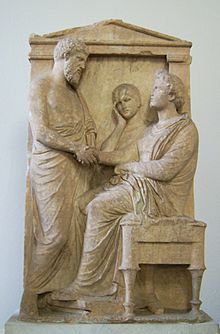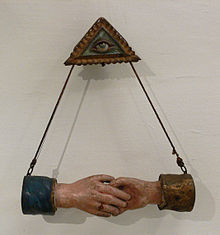Handshake
![]()
This article is about the gesture. See also: Håndslag or Handshake.
Shaking hands is a common non-verbal greeting and farewell ritual in many Western countries. In other cultures, however, it is traditionally uncommon or restricted to same-sex contacts - especially among men.
Like many other greeting ceremonies, it is usually performed with the right hand, except in the handshake of the Scout salute, where it is performed with the left. The hands clasp each other for a few seconds and are often moved rhythmically up and down. If this movement is missing, it is sometimes called a handshake. A precursor might be the waving, which originally served to present the empty hand of the weapon to the counterpart. When shaking hands, the direct physical contact is added. Depending on the culture, the hug and the kiss on the cheek can be seen as even more intimate.
In the Western world, a strong handshake is usually considered a sign of self-confidence, strength and willpower. A very weak handshake, however, can evoke negative associations. In other regions, especially in Asian countries, a strong handshake is considered rude.
Public handshakes in the media society are sometimes repeated several times at the request of cameramen and photographers.
It is to be distinguished from holding hands, which is an expression of affection between two people.
From a health point of view, shaking hands, especially with persons who do not belong to one's own household, is controversial for reasons of infection protection. Pathogens transmitted in particular by droplet and smear infection are passed on by handshaking. In the wake of the 2020 global COVID-19 pandemic, there have been increased calls for people to refrain from shaking hands. Celebrities and top politicians who nevertheless continued to practice the greeting in public were subject to criticism.

Handshake

Greek tomb relief of Thraseas and Euandria, Berlin Collection of Classical Antiquities in the Pergamon Museum (Sk 29), ca. 375-350
Background
When shaking hands, the participants take a sample of the smell of the other person. Scientists have found that people often bring a hand to their face after greeting someone. The reason for this is the analysis of the body's own scents transmitted during handshaking.
History
The tradition of shaking hands was already known in the Roman Empire. On Roman coins, handshakes can be found as a symbol of harmony. In the time of the Republic, the gesture was only customary at a reunion after a long absence or as an expression of special solidarity. It was not until the imperial period that it became more common. In the New Testament, Paul's letter to the Galatians (written about 50 AD) mentions that Paul was given the "right hand of friendship" when he left Jerusalem. The custom probably came into its present form through the Quakers in the 17th century as a simplifying and more equal form of greeting (etiquette).

Fraternal hands with eye of God. Masonic symbol, Austria around 1800
Search within the encyclopedia